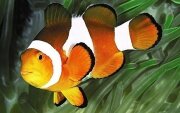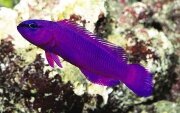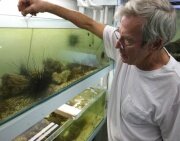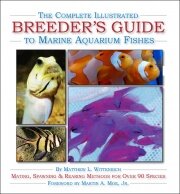Foreword: Breeder's Guide to Marine Aquarium Fishes
From Microcosm Aquarium Explorer
Contents
|
A Quixotic Dream
Marine Fish Breeding: Once an Impossible Notion
By Martin A. Moe, Jr.
The Past
The year was 1972. Marine aquarium keeping, in the infancy of its modern form, was barely 10 years old. An arcane appendage of the freshwater aquarium world, the marine hobby of the time was saddled with the technology of the late fifties and sixties: rust-prone tanks with metal frames and slate bottoms, under-gravel biological filters, pale fluorescent lights, paltry water circulation driven by airstones, and bleached coral skeletons for decor. A few species of hardy marine fishes were available and these were the only observable life to be found in most of these stark early marine aquariums.
The idea of breeding marine aquarium fish had been alive for years but until then had never been realized. One of the deterrents was a lack of fundamental understanding of the marine environment. Marine aquarium keeping sprang out of the established ideas and technology of the freshwater hobby.
Most aquarists in the 1950s and sixties were not biologists, much less marine biologists, and their understanding of aquatic ecosystems was grounded in the freshwater environment. In freshwater, almost everything happens on the bottom. Fish spawn and little fish grow up in the same general areas as the adults, most plants and invertebrates are benthic (on the bottom), few float or swim very far, and although plankton exists, it is not the critical biological factor that it is in the marine environment. The bottom basically contains the entire biological ecosystem, including fish reproduction, which can be adequately replicated and managed within the confines of an aquarium.
In contrast, the ecosystem of a marine environment is only partially present on the bottom. Most marine organisms, including almost all marine fish, depend on the shifting, flowing world of the plankton (a soup of marine life forms of all sizes, including microscopic phytoplankton and zooplankton) for sustenance and for distribution of eggs and larvae. The plankton hosts these larvae for extended periods, feeding them and distributing the late larvae to areas where they can metamorphose and survive.
An understanding of this ecological dichotomy was not common in the early days of the marine aquarium hobby, and most early attempts at breeding marine fish centered on the benthic environment established in a typical marine aquarium. Such attempts were doomed to failure since few marine fish produce offspring that are competent to survive the early larval period in a benthic environment.
Success in breeding marine ornamental fish was not found until biologists began to work seriously at spawning and rearing these fish with an understanding of the essential nature of the planktonic environment in the reproductive scheme of marine organisms. It was necessary to develop an environment to provide an adequate substitute for the physical, chemical, and nutritional factors essential to planktonic fish larvae. This could better be provided in a tank separate from the little piece of oceanic bottom that maintained the broodstock. Matthew Wittenrich discusses all of this well in Chapters 8 and 9 of this book.
The history of breeding and commercial production of marine ornamental fish began in the early 1970s. At that time, spawning and rearing saltwater aquarium species (now known as marine ornamentals) was considered, for the most part, impossible. There had been some success in rearing a few marine fish, one or two at a time, at marine laboratories and public aquariums, but production of commercial numbers of marine aquarium species was but a quixotic dream.
The dream was realized, however, in late 1972, and I can tell you how it happened. I was there.

After working as a fishery biologist for the State of Florida for almost 10 years, I took a job in 1969 with a fledgling aquaculture company whose goal was to develop the technology for rearing pompano, a commercially valuable subtropical marine fish with delectable eating qualities. Finding a first food for the just-hatched pompano larvae was one of the major challenges, but we did it.
The key to our success was a very small and easily cultured marine rotifer that was then in use at Scripps Institution of Oceanography in La Jolla, California where they were studying plankton dynamics. We thought that this rotifer might be useful in feeding larval pompanos, and we obtained a starter culture from Dr. Ruben Lasker. This experiment led to success and large-scale production of juvenile pompano.
I left that job in 1971 to return to a doctoral program at the University of South Florida. During that first year my academic ambitions waned, and my thoughts turned to propagation of marine tropical fishes. After some research, the first species I focused on was the Common or Ocellaris Clownfish (Amphiprion ocellaris). It was well-suited to aquaculture: it was content to live in a small territory and was a demersal spawner with relatively large eggs and larvae. It was also in great demand in the hobby, a market—maybe thanks to “Nemo”—that has yet to be fully satisfied.
I built a small hatchery in my garage in the Florida Keys and bought a few adult clownfish. The first spawn came in November of 1972, and that resulted in eight juveniles. I thought it a good initial success. Production soon rose into the hundreds, and I was actually selling juvenile clownfish in early 1973 for the grand sum of 35 cents each.
The die was cast, my fish-farming fever rose, and I started a little company, Aqualife Research, to try to make commercial production of tank-raised marine aquarium fish a reality. I never did finish that doctoral program. As with most things in the scope of human endeavor, once something is shown to be possible, interest and effort becomes more intense and technology advances rapidly. Soon a number of other aquarists, hobbyist and professional, bent their attention to breeding clownfish.
Frank Hoff and Tom Frakes, working for Aquarium Systems, joined the fledgling industry in 1974 just down the block from my Aqualife Research hatchery, and we competed for quite a few years. Then Chris Turk, who worked for me at various times and places in his youth, started a clownfish hatchery with Sea World in California, and for a number of years these three companies were the only commercial breeders of ornamental marine fish.
Commercial propagation of marine ornamental fish is one of those things that look great on paper, but the reality is painfully different. A litany of things can, and will, go wrong. The old witticism—“You can make a small fortune breeding marine ornamental fish as long as you start with a large fortune”—has been proved true time and again.
By the mid 1990s, all three of the first-generation of commercial marine ornamental fish hatcheries had passed from the scene. But new hatcheries, some large and some small, some in the US and others in various foreign countries, answered the siren song with multitudes of impossibly colored, incredibly valuable, little marine fish crowded into tanks of crystal-clear saltwater. Some of these hatcheries still exist and some have faded under the technical and financial realities that aquaculture presents. Still, the potential to breed marine aquarium species is alive and well and many of us still get feverish at the thought of being the first to propagate a new species.
The Present
The field has changed considerably since those early years. We have a better understanding of how to create and manage large and small marine aquariums, and reef tanks populated with live coral and formerly difficult-to-keep fishes. Captive, micro-scale approximations coral reef ecosystems, once an impossible dream, are now commonplace. Aquarium equipment specially designed for marine aquarists—all-glass and acrylic tanks, high-intensity lights, efficient filters, protein skimmers, saltwater pumps and hi-tech wavemakers, specially formulated marine foods, sea salt mixes and chemicals, along with many other innovations—are now in the category of “off the shelf” rather than having to be adapted from the freshwater world.
Strangely enough, once it became possible to maintain and culture photosynthetic corals through vegetative fragmentation (growing new colonies from cuttings), coral culture quickly surpassed the much older efforts to breed marine fish. The reason for this goes back to that dichotomy of the marine ecosystem with benthic and planktonic environments, separate, yet vitally biologically entwined.
Although vegetative coral culture can be accomplished on a benthic substrate, successful culture of marine fish with planktonic larvae demands creation of an adequate substitute for both the benthic and planktonic marine environments. Only a relatively few hobbyists in the world are now willing and able to do this. This book will certainly help many other hobbyists to venture into this demanding, but very rewarding branch of the marine aquarium hobby.

The explosion of the reef tank, coral-culture branch of the marine hobby has also had the interesting effect of increasing the demand for small, colorful fish with intriguing behavior that are adaptive to reef tanks—precisely the type of fish that are most easily cultured. These species, such as clownfishes, gobies, and dottybacks are small as adults, spawn readily in the confines of an aquarium, and can be reared through the larval stages with equipment and techniques that can be applied in Chicago as well as Hawaii. These fish have been and are the mainstay of current commercial marine ornamental marine fish hatcheries. However, despite the 35-year history of marine fish culture, only 2 to 10 percent of the current marine fish market in numbers and in species are tank-reared.
The current dynamics of marine ornamental fish culture are driven by scarcity, price, and protective environmental laws. These factors function together both economically and emotionally to increase the value of marine ornamental fish, and concomitantly make tank-raised fish more competitive. Clownfish are undoubtedly the most common tank-reared species. In fact, clownfishes, particularly Amphiprion percula and Amphiprion ocellaris, are becoming available in various genetically stable color morphs, a development that mirrors the early culture of the Crucian carp (goldfish) in China 1,500 years ago and the discus during the last century, as well as many other species of freshwater aquarium fish. I thought that this might develop when I first bred this species back in 1972 and I’m glad I lived to see it begin.
There are two reasons why there are so few species of tank-raised marine ornamental fishes in the aquarium trade today. The first and most significant is that it is not easy to culture marine fishes, especially to develop the skills necessary to be successful at this endeavor. Only a few species lend themselves to culture far from the sea, and it is expensive in both time and dollars to engage in this pursuit for either fun or profit. The technology to culture some of the most-prized species—angelfish, tangs, and butterflyfish for example—is still in development, and the culture of these species by hobbyists is still the impossible dream. And the second, most important to a commercial venture, is that only a few species enjoy the extensive market demand, ease of culture, and a high stable price to support the effort and expense of commercial culture. The big news, however, is the growing number of hobbyists who have the passion and drive to rear marine fish in small home hatcheries.
The techniques for rearing clownfish are now well known and many hobbyists now do so. Books by Wilkerson, Hoff, myself, and now Wittenrich have described the basic technology for hobbyists. But perhaps the driving force for this development is the Internet, the information that is available at the click of a mouse, and the new ability of breeders to share experiences, information, and even fish through personal contacts where geographical distance is a minimal factor. And one of the most important parts of this development is that these new and passionate breeders of marine ornamental fish are not constrained by the commercial value of the object of their endeavors. No, they can work with whatever species captures their interest: Emerald Clingfish, or Royal Grammas, or blennies, or dragonets, or obscure gobies, whatever their interest determines and through that work advance the future of the whole field of marine fish culture.
The Future
Ahh, the future . . . Soon we’ll be able to take a clipping from a fin and create vast numbers of cloned angelfish of unimaginable beauty and hardiness, then keep them in fantastic contained ecosystems controlled by technology we can’t imagine. Or maybe not . . .
The future has ways of developing along positive and negative pathways we can’t foresee. Predictions are rarely accurate. Biology does not change, but the technology through which we manipulate biology is constantly evolving. I think (barring total catastrophe, which, by the way, is not impossible) that we will deepen our understanding of the biology of marine fish reproduction and early life history in the years ahead, and through that understanding, develop better methods for successful breeding of many species of marine fish.

The highest value fish, of course, such as pygmy angelfish, will be the object of the most intense research, and we will see a number of these species enter the commercial trade in the not-too-distant future. I think that eventually we will see commercially available live foods for the early larvae. Food organisms of the proper nutritional constitution and free from bacterial and environmental toxins that are reared and processed in large quantities and available to hobbyists just as live brine shrimp, rotifers, and some copepods are today. Water quality and bacterial control (not only the prevention of bad bacteria but also the enhancement of good bacteria) will be an important factor in development of the aquatic environment for the culture of marine fish larvae, and the commercial farming of marine food fish will surely lend critical information to its ornamental cousin. Technology allowing, the culture of marine fish will follow to some extent the history of the culture of freshwater fish, but it will take much longer, and people who accomplish it will be more knowledgeable and dedicated to an important mission.
It is not possible to protect and preserve things that are not known, and not revered. A wetland, for example, is not likely to be protected from filling and development, or a coral reef from destructive fishing, pollution and climate change, unless the public is aware of the beauty and essential value of that ecosystem to human life. The marine aquarium hobby is a beacon, a focus, a guidepost, a candle in the dark, a bellwether, and a critical outreach pulpit for the relatively small number of us who love and care for the ocean’s creatures—to educate the many who do not know and do not care, at least not yet. Everyone who keeps a marine aquarium is, in one way or another, an ambassador from the oceans and reefs to all of humanity.
We know what to do: preserve what can be preserved, fight to control pollution, prevent senseless ecological destruction, live with a small carbon footprint, and most important, curtail and reverse production of greenhouse gasses. Some of us believe that breeding marine fishes is part of the solution, and now we have Matthew’s important new book as guidance and inspiration.
Martin A. Moe, Jr.
From: The Complete Illustrated Breeder's Guide to Marine Aquarium Fishes










